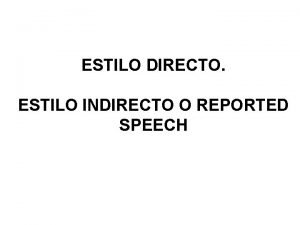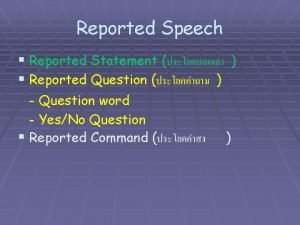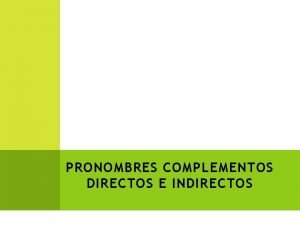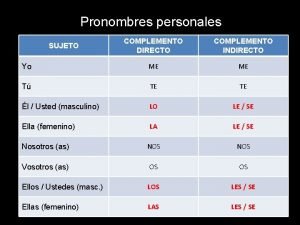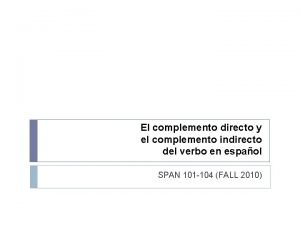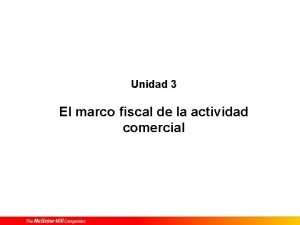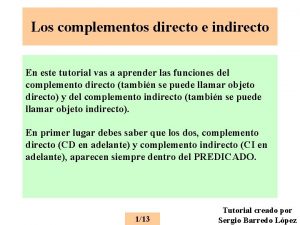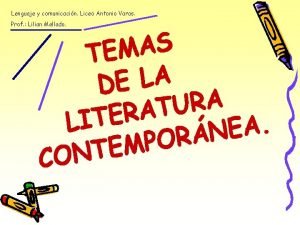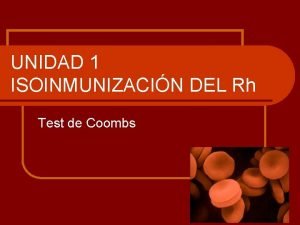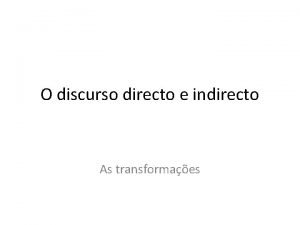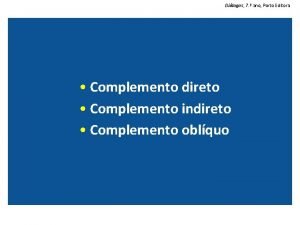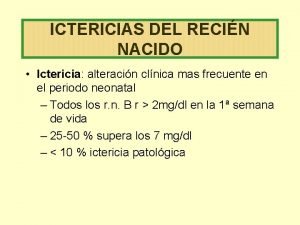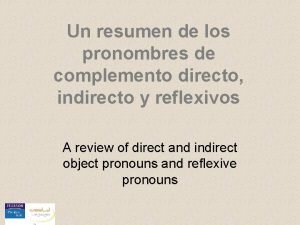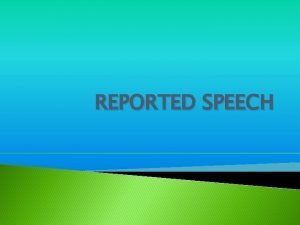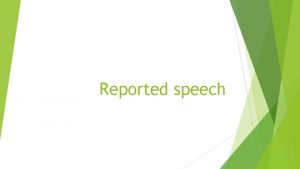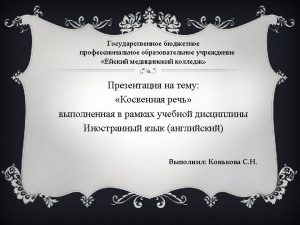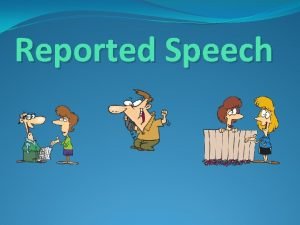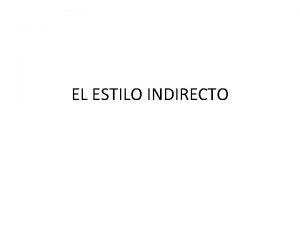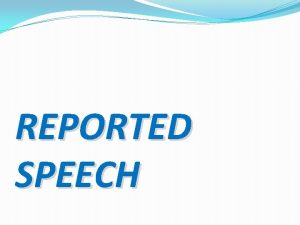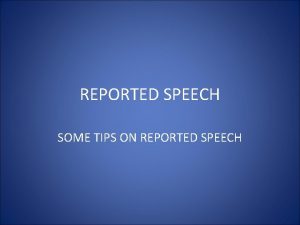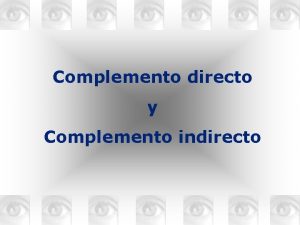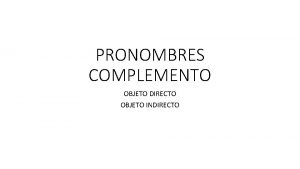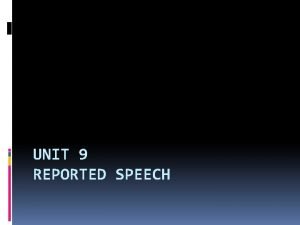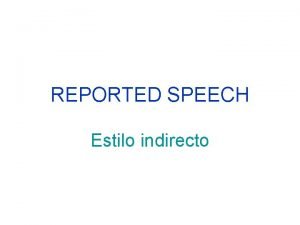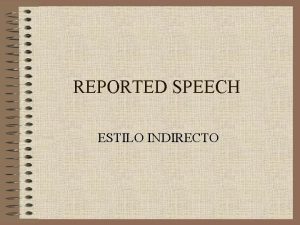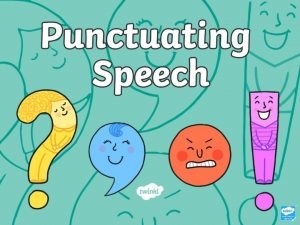ESTILO DIRECTO ESTILO INDIRECTO O REPORTED SPEECH ESTILO


















- Slides: 18

ESTILO DIRECTO. ESTILO INDIRECTO O REPORTED SPEECH

ESTILO DIRECTO O DIRECT SPEECH Ø Cuando queremos informar exactamente de lo que otra persona ha dicho, utilizamos el estilo directo. Con este estilo lo que la persona ha dicho se coloca entre comillas (". . . ") y deberá ser palabra por palabra. Ejemplos: Ø "I am going to London next week, " she said. ("Voy a Londres la semana que viene, " ella dijo. ) Ø "Do you have a pen I could borrow, " he asked. ("¿Tienes un bolígrafo que puedas prestarme? , " él preguntó. ) Ø Alice said, "I love to dance. " (Alice dijo, "Me encanta bailar. ") Ø “I am visiting my grandpa today” Tom said.

INDIRECT SPEECH O REPORTED SPEECH (ESTILO INDIRECTO) Ø Sin embargo en el Estilo Indirecto reproducimos lo que alguien dijo pero no literalmente, no reproducimos exactamente las palabras del emisor: Tom said that he was visiting his grandpa that day Ø La información es la misma, pero hay ciertos cambios en la estructura:

CAMBIOS QUE SE PRODUCEN EN REPORTED SPEECH 1. 2. 3. 4. 5. 6. 7. 8. PRONOMBRES ADVERBIOS DEMOSTRATIVOS VERBOS AFIRMACIONES INTERROGACIONES SUGERENCIAS ÓRDENES, CONSEJOS

1. PRONOMBRES • Normalmente los pronombres cambian a 3ª persona del singular o plural. I/me/my/mine He/she/his/hers You/yours Him/his/hers We/us/ours They/theirs


2. ADVERBIOS • Now ——— then// at that moment • Today ——- that day • Tonight ———— that night • Yesterday — the day before// the previous day • Tomorrow —- the next day// the following day • The next day/month/year… — the following day/month/year… • Last week——————- the week before • Ago —————- before//previously • Here ————— there

3. DEMOSTRATIVOS • This ———– that • These——— those

4. VERBOS • Tan sólo debéis recordar que todo lo que se dice en Estilo Directo cambiará al pasado en Estilo Indirecto. Siempre iremos un paso hacia atrás en el tiempo. (EL PAST PERFECT NO CAMBIA)


MODALES ESTILO DIRECTO MODALES ESTILO INDIRECTO Can Could May Might Must Had to Should

5. AFIRMACIONES • A. El estilo indirecto puede ir introducido por un verbo en presente: He says that…. Esto es lo normal cuando: • Estamos relatando una conversación que aún continúa. • Estamos leyendo una carta y relatando lo que dice. • Estamos leyendo instrucciones y relatandolas. • Estamos relatando una oración afirmativa que alguien dice a menudo: Tom says he will never get married. • Si el verbo que comienza la oración está en presente, present perfect o futuro, podemos contarlo sin hacer cambios en la oración: Paul (phoning from the sation) I’m trying to get a taxi. ANN(to Mary, who is standing beside her): Paul says he is trying to get a taxi.

• Pero normalmente las oraciones en Estilo indirecto van introducidas por un verbo en pasado, para ello debemos cambiar el tiempo verbal de lo que estamos relatando siguiendo el cuadro mencionado anteriormente:

6. Interrogativas/ Preguntas A. Pregunta en Estilo Directo: He said, “Where is she going? ” B. Pregunta en Estilo Indirecto: He asked where she was going. C. Cuando pasamos preguntas en estilo directo a estilo indirecto, los siguientes cambios son necesarios: D. Tiempos verbales, pronombres y adjetivos posesivos, y adverbios de tiempo y lugar cambian como en las afirmativas. E. La forma interrogativa del verbo cambia a afirmativa. F. Las interrogaciones se omiten G. Si el verbo que introduce la oración en Estilo Indirecto es “say”, tiene que ser cambiado a ask, wonder, want to know etc. : He said “Where is the station? / He asked where the station was.

H. El verbo “ask” puede ir seguido por la persona a la que se le está preguntando (CI): He asked “What have you got in your bag? / He asked me what I had got in my bag. (Recuerda que wonder y want to know no pueden llevar complemento indirecto) I. Si la oración en Estilo Directo comienza con una Question Word (when, where, who, how, why, etc. ) la uestion word se repite en Estilo Indirecto: He said “Why didn’t you put on the table? / He asked (her) why she hadn’t put on the table. J. Si no hay question word, If o Whether deben ser usados: “Is anyone here? ” he asked / He asked if/whether anyone was there.

7. Sugerencias A. Ofrecimientos: “Shall I bring you some tea? ” en Estilo Indirecto sería: He offered to bring me some tea. B. Sugerencias: “Shall we meet at theatre? en Estilo Indirecto sería: He suggested meeting at theatre.

8. ÓRDENES. CONSEJOS • Orden Estilo directo: He said, “Lie down, Tom”. • Orden Estilo Indirecto: He told Tom to lie down. Las órdenes, peticionies y consejos en Estilo Indirecto se expresan normalmente por un VERBO+COMPLEMENTO+INFINITIVO. • Se pueden usar los siguientes advise, ask, beg, command, order, remind, tell, warn etc. • He said, “Get your coat, Tom!” / He told Tom to get his coat. • En negativa, not + infinitive: “Don’t swim out too far, boys”, I said / I warned/told the boys not to swim out too far.

9. EXCLAMATIVAS • Las exclamativas normalmente se convierten en afirmativas en Reported Speech; los signos de exclamación desaparecen. • Las exclamativas que comienzan por What… o How… pueden ser relatadas con los verbos: exclaim/say that: He said, “What a silly idea!” or “How silly!”/ He exclaimed that it was a silly idea/was silly.
 Reported speech ordenes
Reported speech ordenes Estilo directo e indirecto
Estilo directo e indirecto Ahora estilo indirecto
Ahora estilo indirecto In bangkok reported speech
In bangkok reported speech Complementos directos e indirectos
Complementos directos e indirectos Pronombres personales de complemento directo
Pronombres personales de complemento directo Complemento directo vs complemento indirecto
Complemento directo vs complemento indirecto Complemento directo e indirecto
Complemento directo e indirecto Impuesto sobre el patrimonio directo o indirecto
Impuesto sobre el patrimonio directo o indirecto Complemento directo e indirecto
Complemento directo e indirecto Ilogicidad del mundo
Ilogicidad del mundo Test de coombs directo e indirecto
Test de coombs directo e indirecto Discurso directo e indirecto
Discurso directo e indirecto Complemento oblíquo
Complemento oblíquo El complemento directo
El complemento directo Pronombres de objeto indirecto
Pronombres de objeto indirecto Coombs
Coombs Que son los elementos en un texto
Que son los elementos en un texto Complemento directo
Complemento directo
